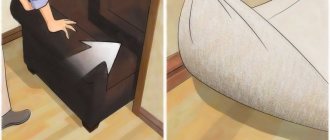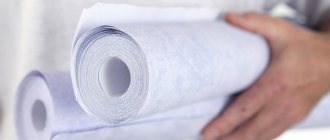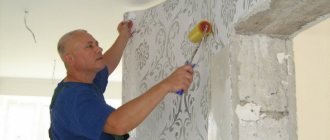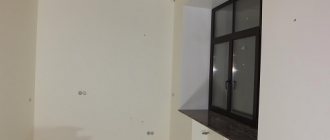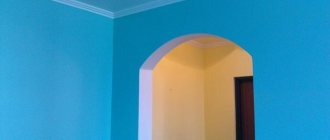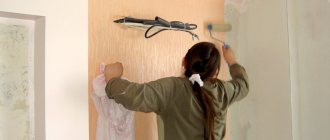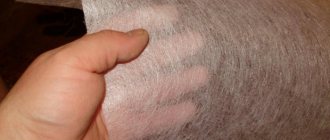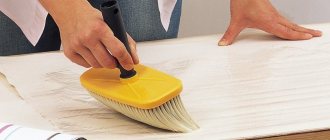If you do not have the relevant experience, then it is not recommended to glue new wallpaper over old ones. It would be nice to carry out the repair quickly, in a short time, and even on a budget. This means that you need to do it on your own. Is this always possible? And won't such savings affect the quality of work? If you do everything correctly, the savings will be significant, and it is better to buy wallpaper that is more expensive and more beautiful than to give extra money to the craftsmen.
Problem: you can glue wallpaper onto old wallpaper
The surface of the walls should always be prepared before pasting - any professional will tell you this. Gluing over old ones is a risky undertaking. And the point is not even that the new wallpaper may come off or will somehow not stick very well. The point, rather, is that the wall is not prepared for new repairs. But sometimes it needs to be leveled and primed.
But sometimes you just really need to put on new wallpaper without removing the old ones. In what situations does this happen? If you have very little time, you need to save energy, money, and time. If the walls are smooth, no preliminary leveling is necessary.
New wallpaper can be glued over old ones if the old ones are small in thickness and there are no serious damages to them
But with this option, these conditions must be met:
- Old wallpaper must be only paper;
- Even if old wallpaper is very firmly, “tightly” attached to the wall;
- The surface of the wallpaper should not be textured or embossed, it should be completely smooth;
- Old wallpaper should be thin.
Related article: Features and tips for painting OSB boards indoors
That is, as you can see, such wallpapering requires quite serious conditions. And the previous layer is not always paper wallpaper. And if you glue it to vinyl, then you definitely don’t expect a good gluing. It won’t take on well, and then, most likely, it will come off in two layers at once.
How to properly glue wallpaper over old ones
Gluing new trellises onto old ones is carried out in compliance with certain rules:
- the old base must be securely held on the wall, its surface must be flat;
- the base should be paper material without relief, its color should be lighter than the top layer;
- gluing is done over the area of the joints of old fragments in order to securely fasten the canvas;
- The glue is applied in an even layer so that bubbles do not appear and the new finish does not move off.
Glue selection
When new wallpaper is purchased, you need to choose the right adhesive mixture that will ensure strong adhesion to the base. The following selection parameters need to be taken into account:
- weight, type of canvas;
- base type;
- humidity and temperature in the room.
Trellis can be glued to a universal compound; the main thing is to prepare the glue strictly in accordance with the manufacturer’s recommendations for a specific type of finishing material and base. It is better to glue vinyl sheets to specialized compounds with antifungal ingredients that can hold a large mass of this material.
Preparation
Before gluing new canvases, you need to carefully strengthen all the weak points of the old coating. Cracks are puttied, all surfaces are leveled, any bubbles are pressed through gauze with a hot iron.
To improve the adhesive properties of the base, it must be pre-treated with a deep penetration primer. After an hour, you can prime the surface a second time. The glue is applied after the soil has completely dried.
Sticking
To work you need:
- spatula and putty, which will be used to smooth out plaster defects;
- brush or roller for applying adhesive mass;
- roller for leveling canvases and removing air bubbles from under them;
- rags for removing excess glue;
- knife or scissors for cutting the roll.
Pasting is carried out using the following technology:
- The required amount of adhesive mixture is diluted.
- Any drafts are eliminated from the room.
- A sheet of the required length is cut from the roll, taking into account the pattern (if adjustment is needed) and with a gap of 5 cm. Small pieces can be used above door and window openings, as well as behind radiators.
- The adhesive is applied to the surfaces indicated on the roll. Depending on the type of trellis, the wall, the reverse side itself, or both the material and the base can be coated.
- The canvas is applied to the wall, starting from the ceiling downwards. Its central part should be at the junction of the old finish.
- Use a roller to remove air bubbles from under the canvas.
- Use a dry cloth to remove excess adhesive mixture along the edges.
To ensure that the new material is securely attached to the old finish, it is recommended to first glue one canvas and wait a day. If the material does not fall off, you can continue gluing.
During operation, the air temperature should be +15…+25 °C. You can open the windows in the room only after the adhesive mixture has completely dried. Drafts should not be allowed during drying, and it is not recommended to turn on the air conditioner.
Cons: wallpapering old wallpaper
Certain shortcomings, or, as people call them, “jambs,” most likely cannot be avoided. And if you decide to save time, you should be prepared for them. Still, the gluing technology is broken.
If we were to glue good new wallpaper on top of the old ones:
- The aesthetics of the selected pattern will decrease;
- The quality of fastening of the new wallpaper will also be insufficient;
- The risk of gluing defects is more than great - these include numerous “bubbles” and partial peeling;
- Bacteria and mold can grow under the fibers, which are dangerous to your health.
If you glue new wallpaper over old ones, then after some time defects may form on them
Well, if you glue white, light and/or thin wallpaper over old ones, such a sticker is already doomed to failure. You can’t stick it exactly like this - the previous layer will be too noticeable. There will be a feeling of dirty, sloppy work.
Types of wallpaper and their characteristics
Is it possible to glue wallpaper onto old wallpaper if the old one is painted? But what if the coating for a new canvas is vinyl, cork, non-woven or liquid based? Of course, it is impossible to list all situations, so we will consider only a few.
Paper
Paper-based wallpapers are the most convenient in terms of gluing on each other. They fit well both on top of old ones and can be an excellent basis for another top layer, since this type is the thinnest. Nowadays, a “layer cake” made from paper wallpaper is often found. It is only important that the old color palette does not overlap the new one.
New materials are entering the market with a base made of thicker paper, which should be handled carefully. Their multi-layered nature threatens peeling.
How to hang wallpaper on old wallpaper: subtleties of the process
Let's say that your walls are covered with thin, smooth paper wallpaper, and you are planning to glue new ones on them. However, before work, check that the old canvas does not have any defects, that there are no tears, and that all joints are carefully connected.
One more nuance: it is possible that old wallpaper will suddenly show its coloring properties; this can be activated when it gets wet from the new glue. And then, of course, all the work is down the drain.
So, you are convinced that the old wallpaper is holding up perfectly. And yet, moisten the base, and tear off those pieces that fall off on their own. And then the work proceeds in the usual way, but only a test pasting is done first. This means you glue one strip and wait for it to dry. Wait at least an hour, if everything is fine, continue gluing.
Related article: Basic malfunctions of the cistern and their repair
Advantages of non-woven wallpaper
Tools for wallpapering.
Today, the market for decorative finishing materials offers a lot of options for renovating an apartment or house. When choosing a material for gluing walls, you should take into account the existing disadvantages and positive aspects of the finishing material.
Non-woven wallpaper is made using a rather complex technological process based on compressed fabric and paper fibers. It is noteworthy that this material is highly strong, durable, resistant to fire, and also has soundproofing properties. The color palette and variety of textures and reliefs will allow you to bring any design solutions to life. All these advantages have become possible thanks to modern technologies, which have significantly increased the service life of finishing materials. Non-woven fabric does not emit harmful substances if it does not have vinyl components. In addition, such wallpaper can be painted with acrylic or dispersion paint if necessary. Often this opportunity is used by families with small children who love to paint the walls, puzzling their parents. High cost is the only significant drawback of non-woven wallpaper.
Related article: Using Aquastop primer for waterproofing
Preparing walls: how to remove old coating
But let’s say the work didn’t go well. You realized that high-quality gluing would not work, and you decided to clear the wall of the old wallpaper. You should not be afraid of this process, especially since it can be significantly accelerated.
It is convenient to remove old wallpaper using a regular spatula
You can quickly remove old wallpaper from the wall:
- By causing scratches to the wallpaper;
- Wetting the wallpaper;
- Scraping off the old coating.
It is worth remembering that the degree of water permeability of different wallpapers is different. In order for water to penetrate the material as much as possible, it is necessary to destroy the entire integrity of the coating. This is usually why scratches are made. Scratched in a large number of places, then the surface needs to be thoroughly moistened.
By the way, there is also a special composition on sale, a solution for removing old layers of wallpaper. It acts on the glue under the wallpaper, making it easy to remove from the wall. But this is usually necessary if the wallpaper cannot be removed using more traditional methods. If the glue literally holds tightly. But this doesn’t always happen.
The solution itself is applied to the wall, but it should not flow down the surface. After the surface is wetted, it should be left alone for half an hour. And then you can safely remove the old layers. Usually, in such conditions, scraping takes a little time. And, by the way, wallpaper can be removed not with some special spatula, but even with an ordinary ruler.
DIY wallpapering
It is allowed to paste over the walls only after all defects on the walls have been corrected and the putty and primer mixture have dried. You can find out how long it takes for the primer to dry on the walls from our review.
Stages of work:
- Using a roller or large brush, prime the old surface. Yes, even with this method of gluing this work cannot be avoided. This is not difficult to do: take a regular acrylic primer or wallpaper glue, dilute it with the required amount of warm water and carefully process it so that there is not a single uncoated area left, wall material in one layer. After drying, the base will be completely ready for use.
- While the primer dries, cut the canvas into pieces, taking into account the pattern with an allowance of 5 centimeters. For this process, we measure the height of the walls in advance.
- Next, you need to prepare the glue as indicated in the manufacturer's instructions on the package. If the budget does not allow or there is no great desire to run to the store, then you can cook a paste from starch and flour at home.
- We apply glue, again according to the instructions on the package (only on the sheet or on the wall). Be careful that the surface of the canvas or wall is coated with an even and neat layer of glue. Since a large amount of adhesive composition can create a humid environment, and this can lead to damage to the facing material.
- Further actions are no different from the standard process. You need to start gluing from any corner of the room. You need to lean the strip of canvas on top and gradually apply it along the entire length of the wall, from the ceiling to the bottom point.
- Using a roller you can get rid of air bubbles and irregularities, and wipe off excess glue with a rag. If the joints are not glued well enough, re-coat them with glue and roll them again with a roller.
To make sure everything is done correctly, you can leave one strip for a day. If no defects appear, then you can continue gluing according to the same plan.
What is non-woven fabric
Anyone who is familiar with tailoring knows perfectly well what it is. Non-woven material is made of textile and cellulose fibers, which are bonded with a polymer binder material, thanks to which the interlining is quite durable.
And if we take into account that the thickness of the non-woven fabric is quite small, we get an excellent material for strengthening clothes.
Non-woven wallpaper?
Pasting the ceiling
The not quite correct name is confusing. In fact, non-woven coverings are not 100% non-woven. This material is used only in a durable base onto which vinyl is sprayed.
Thanks to this base, the canvases are stronger and lighter, which guarantees durability when decorating walls with your own hands.
Advantages
- Vinyl wallpaper with a paper backing is heavier and has a shorter service life.
- Non-woven coatings do not stretch, dry out or deform over time.
- They are easy to stick on and remove from the wall during renovation.
- They are often purchased to create microrelief. Once painted with acrylic or dispersed paint, they can be washed and even repainted.
- The texture is produced in a very diverse range, simulating different types of relief plaster. There are canvases with an imitation of a three-dimensional pattern, almost a bas-relief.
- Improves sound insulation in rooms.
- They allow air to pass through well and breathe.
- They do not contain fiberglass or PVC.
- Increased fire resistance.
How to stick non-woven wallpaper on plaster?
Gluing non-woven wallpaper onto plaster is the most common method. It is only important before starting pasting to level the plaster with sandpaper (with an abrasive mesh on a block and treat the surface of the plaster with putty. If you use finishing plaster with a fine grain size, you can do without putty. But after treating the plaster with sandpaper, you need to sweep it with a broom and treat it with a primer (acrylic) .
It is advisable to use plaster as a base for gluing non-woven wallpaper to preserve the “breathable” properties of the wallpaper. In damp rooms, you can add PVA emulsion or liquid glass to the plaster. This will increase resistance to mold formation and wetness of external walls.
If the walls under the old wallpaper are already plastered, after removing the wallpaper, you should carefully inspect the plaster.
Carefully fill all cracks and defects, and treat the old plaster with a primer before gluing new wallpaper.
Gluing wallpaper onto wallpaper: step-by-step instructions
If you are sure that all conditions are met, feel free to move on to the process itself. To do this, you will need at least the simplest non-professional tool: a roller, scissors, a knife, material for wiping off glue, a spatula, a glue tray. Materials: wallpaper glue, putty, primer.
Preparatory work. We start with repairing the surface: we fill the cracks with putty, carefully glue all the seams on the old layer and glue the lagging elements.
We prime the old wallpaper using glue and primer. A necessary operation when you need to paste wallpaper onto wallpaper. Wallpaper glue is suitable for these purposes.
While the primer is drying, you can prepare the canvas for application. Typically, for a single-color material, the roll is cut into several equal parts. If there is a pattern, the material will have to be cut so that the pattern at the junction of the canvases matches. Precision and measurements required.
What to do if there is no way to remove old wallpaper?
But even in the most hopeless situations, there is a way out. To reduce the risk of old wallpaper peeling and achieve an acceptable result. By gluing new non-woven wallpaper, you can create a waterproof coating on the surface of the old wallpaper. This can be done: either by treating the old wallpaper with an aqueous solution of PVA emulsion, or with silicate (liquid glass), and oil paint with sandpaper. In both cases, a thin waterproof film is formed on the surface of the paper wallpaper, susceptible to most types of wallpaper glue (based on modified starch).
Before gluing new wallpaper, you can add PVA emulsion or bustylate glue to standard glue - its adhesive characteristics will only increase. True, you have to forget about the breathability of the wallpaper.
There is no need to paint non-woven wallpaper pasted in this way.
Even despite the waterproofing layer, it is still very conditional. By applying paint to new wallpaper, old wallpaper can become saturated with moisture and peel off from the wall.


